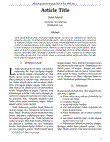Resultados de búsqueda - "chromium"
Materias dentro de su búsqueda.
Materias dentro de su búsqueda.
- feeding 1
- management 1
- shrimp 1
-
1
Metallophilic fungi research: an alternative for its use in the bioremediation of hexavalent chromium
Publicado 2017“…Contamination by hexavalent chromium has had a large impact on modern society and human health. …”
Enlace del recurso
Artículo -
2
Aislamiento de hongos y su uso como material biosorbente con capacidad de remover cromo hexavalente.
Publicado 2017“…Therefore, in the present work the biosorption of hexavalent chromium by different fungal strains is evaluated. …”
Enlace del recurso
Tesis -
3
Aislamiento de hongos y su uso como material biosorbente con capacidad de remover cromo hexavalente.
Publicado 2017“…Therefore, in the present work the biosorption of hexavalent chromium by different fungal strains is evaluated. …”
Enlace del recurso
Tesis -
4
Recubrimientos bimodales de WC-co-VC nanoestructurado aplicados por rociado térmico como alternativa del cromo hexavalente para trenes de aterrizaje.
Publicado 2018“…However, over the last decade there has been concerns about chromates due to environmental, health and safety considerations related to the handling, storage and disposal of hard chromium (Cr6+). Due to this requirement, WC-17 Co bimodal coatings applied by thermal spraying are alternatives to hard chromium coatings applied on landing gears for their wear resistance, corrosion resistance and lower environmental impact. …”
Enlace del recurso
Tesis -
5
Recubrimientos bimodales de WC-co-VC nanoestructurado aplicados por rociado térmico como alternativa del cromo hexavalente para trenes de aterrizaje.
Publicado 2018“…However, over the last decade there has been concerns about chromates due to environmental, health and safety considerations related to the handling, storage and disposal of hard chromium (Cr6+). Due to this requirement, WC-17 Co bimodal coatings applied by thermal spraying are alternatives to hard chromium coatings applied on landing gears for their wear resistance, corrosion resistance and lower environmental impact. …”
Enlace del recurso
Tesis -
6
Caracterización electroquímica de la pasivación de acero inoxidable empleado en la fabricación de fuselajes de helicópteros.
Publicado 2018“…This layer obtained consists of iron and chromium oxides in which the nickel does not vary in its concentration.…”
Enlace del recurso
Tesis -
7
Caracterización electroquímica de la pasivación de acero inoxidable empleado en la fabricación de fuselajes de helicópteros.
Publicado 2018“…This layer obtained consists of iron and chromium oxides in which the nickel does not vary in its concentration.…”
Enlace del recurso
Tesis -
8
Evaluation of wooden materials deteriorated by marine-wood boring organisms in the Black Sea
Publicado 2012“…In the region of Amasra of the Black Sea in Turkey, ships continue to be built from wood, mainly Castanea sativa (sweet chestnut) and Quercus petraea (sessile oak) and therefore are subject to destruction by marine borers. Copper-chromium-arsenic (CCA), used to be one of the most common wood preservatives used in Turkey. …”
Enlace del recurso
Artículo -
9
Surface, Chemical, and Tribological Characterization of an ASTM F-1537 Cobalt Alloy Modified through an Ns-Pulse Laser
Publicado 2021“…Among this group, cobalt-chromium-molybdenum alloys are commonly used. Nevertheless, adverse reactions on tissues caused by the liberation of metallic ions are a limitation. …”
Enlace del recurso
Artículo -
10
Corrosion behavior of AISI 409Nb stainless steel manufactured by powder metallurgy exposed in H2SO4 and NaCl solutions
Publicado 2013“…The results indicate that the samples with boron additions are more prone to corrosion due to chromium carbide precipitation.…”
Enlace del recurso
Artículo -
11
Investigation into the Effects of Citric Acid on the Corrosion Behavior of AM 350 Stainless Steel Using Electrochemical Impedance Spectroscopy
Publicado 2025“…The chemical treatment used to improve corrosion resistance is passivation, forming a compact, continuous, adherent chromium oxide film. This research aimed to investigate the effect of citric acid at different concentrations (citric acid; citric acid + oxalic acid, citric acid + hydrogen peroxide, and citric acid + hydrogen peroxide + ethanol) on AM 350 stainless steel passivated for 90 and 120 min at 25 and 50 °C and immersed in 5% by weight sodium chloride (NaCl) solutions. …”
Enlace del recurso
Artículo -
12
Apparent digestibility of dry matter, crude protein, and amino acids of six rendered by-products in juvenile Litopenaeus vannamei
Publicado 2014“…Experimental diets were formulated with 30% of the test ingredient and 70% of a commercial diet supplemented with 1% of chromium oxide as inert marker. AA contents in ingredients, diets, leached diets, and feces were determined by high performance liquid chromatography. …”
Enlace del recurso
Artículo -
13
Recent Developments in Shrimp Feeds & Feeding
Publicado 2015“…The above is perhaps not surprising since fishmeal and fish oil represent ideal feed ingredients for the aquaculture sector by possessing a nutritional profile approximating to the nutritional requirements of most farmed aquatic species, including shrimp; fishmeal not only being an excellent source of dietary protein and essential amino acids but also being a good source of nucleotides, essential fatty acids, phospholipids, minerals, and trace elements (including calcium, phosphorus, magnesium, zinc, manganese, selenium, iodine, molybdenum, and chromium), and fat soluble and water soluble vitamins (including vitamin A, D, E, choline, inositol, and B-vitamins).It follows from the above discussion therefore that efforts to replace fishmeal with alternative and more sustainable protein-rich feed ingredient sources should focus not only on making good any amino acid imbalances through dietary supplementation with aquaculture-grade free amino acids and dipeptides, but must also consider the dietary supplementation of the numerous other essential nutrients usually by fishmeal, including nucleotides, taurine, cholesterol, HUFA, minerals and trace elements. …”
Enlace del recurso
Artículo -
14
Apparent digestibility of amino acids in feedstuffs used in diets for the pacific white shrimp, Penaeus vannamei = Eficiencia digestiva aparente de aminoácidos en ingredientes util...
Publicado 2019“…Experimental diets included 30% of the test ingredient and 69% of a commercial diet supplemented with 1% chromium oxide as inert marker. Amino acid contents in the ingredients, experimental diets, leached diets, and feces were analyzed by high-performance liquid chromatography. …”
Enlace del recurso
Artículo -
15
Apparent digestibility of dry matter, crude protein, and amino acids of six rendered by-products in juvenile Litopenaeus vannamei
Publicado 2014“…Experimental diets were formulated with 30% of the test ingredient and 70% of a commercial diet supplemented with 1% of chromium oxide as inert marker. AA contents in ingredients, diets, leached diets, and feces were determined by high performance liquid chromatography. …”
Enlace del recurso
Artículo


